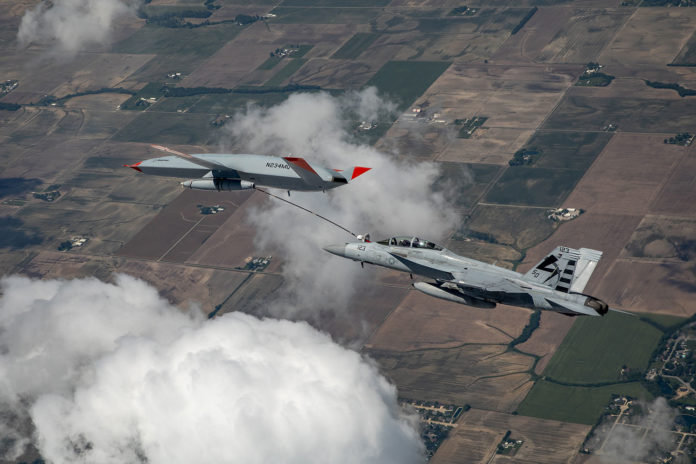The U.S. Navy and Boeing have demonstrated air-to-air refueling using an unmanned aircraft – Boeing MQ-25 T1 test asset – to refuel another aircraft, marking the first time in history.
During the test flight, the aerial tanker drone successfully extended the hose and drogue from its U.S. Navy-issued aerial refueling store (ARS) and safely transferred jet fuel to a U.S. Navy F/A-18 Super Hornet. This test flight successfully demonstrates the MQ-25 Stingray’s ability to carry out its primary aerial refueling mission.
During the initial portion of the flight, the F/A-18 test pilot flew in close formation behind the MQ-25 to ensure performance and stability prior to refueling, a maneuver that required only 6 meters of separation between the MQ-25 T1 air vehicle and the F/A-18 refueling probe. Both aircrafts flew at an altitude and at an operationally relevant speed. Once the evaluation was safely completed, the MQ-25 drogue was extended, and the F/A-18 pilot moved in to “plug” with the unmanned aircraft and receive the scheduled fuel offload.
This milestone comes after 25 T1 flights, testing both aircraft and ARS aerodynamics across the flight envelope, as well as extensive simulations of aerial refueling using MQ-25 digital models. MQ-25 T1 will continue flight testing prior to being shipped to Norfolk, Virginia, for deck handling trials aboard a U.S. Navy carrier later this year.
“Over the next few years, we will work side-by-side with Boeing to deliver this capability that will greatly enhance the future carrier air wing,” said Rear Adm. Brian Corey, who oversees the Program Executive Office for Unmanned Aviation and Strike Weapons.
“This history-making event is a credit to our joint Boeing and Navy team that is all-in on delivering MQ-25’s critical aerial refueling capability to the fleet as soon as possible,” said Leanne Caret, president and CEO of Boeing Defense, Space & Security. “Their work is the driving force behind the safe and secure integration of unmanned systems in the immediate future of defense operations.“
